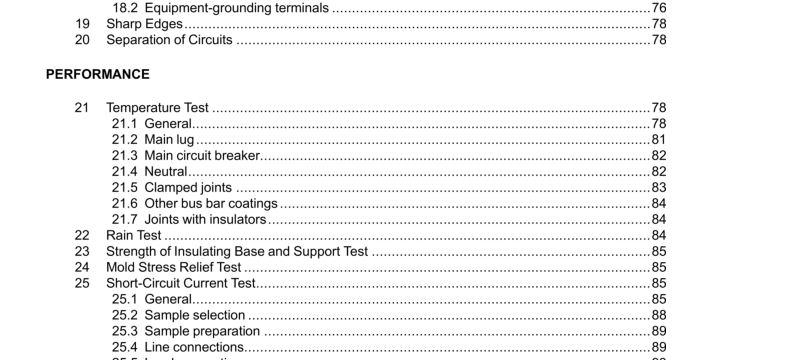UL 67-2020 pdf download.Panelboards.
4 Undated References 4.1 Any undated reference to a code or standard appearing in the requirements of this standard shall be interpreted as referring to the latest edition of that code or standard. 5 Glossary 6.1 For the purpose of this standard, the fllowing definitions apply. 5.2 AMBIENT TEMPERATURE – The temperature of the surrounding medium that comes in contact with the panelboard. For an enclosed panelboard, it is the temperature of the medium outside the enclosure. 5.3 AMPACITY – The current in amperes a conductor can carry continuously under the conditions of use without exceeding its temperature rating. 5.4 AVAILABLE SHORT-CIRCUIT CURRENT – That current which would flow in a circuit if a short-circuit of negligible impedance were to occur at a given point. 5.5 BARRIER – A partition for the insulation or isolation of electric circuits or electric arcs. 5.6 BONDING – The permanent joining of metallic parts to form an electrical conductive path that ensures electrical continuity and the capacity to conduct safely any current likely to be imposed. 5.7 BONDING JUMPER – A reliable conductor to ensure the required electrical conductivity between metal parts required to be electrically connected. 5.8 BONDING SCREW- A screw that is used as a bonding jumper. 5.9 BUS – A conductor, or group of conductors, that serves as a common connection for two or more circuits. 5.10 CABINET – An enclosure designed for either surface mounting or flush mounting and is provided with a frame, mat, or trim in which a swinging door or doors are or can be hung. 5.11 CARTRIDGE FUSE – A fuse consisting of a current-responsive element inside a fuse body with contacts on both ends.
5.12 CIRCUIT BREAKER – A device designed to open and close a circuit by nonautomatic means, and to open the circuit automatically on a predetermined overcurrent without damage to itself when properly applied within its rating. 5.13 Deleted 5.14 CONTINUOUS DUTY – Operation at a substantially constant load for an indefinitely long time. 5.15 CURRENT-LIMITING DEVICE (AC) – An overcurrent protective device that, when interrupting currents in its current-limiting range, will reduce the current flowing in the faulted circuit to a magnitude substantially less than that obtainable in the same circuit if the device were replaced with a solid conductor having a comparable impedance. 5.16 CURRENT RATING – The designated maximum direct current or alternating current (RMS Amperes at rated frequency) that a device can carry continuously under specified conditions. 5.17 CUTOUT BOX – An enclosure designed for surface mounting that has swinging doors or covers secured directly to and telescoping with the walls of the enclosure. 5.18 DEADFRONT – A barrier that prevents live parts from being exposed to a person on the operating side of the panelboard. 5.19 DEADFRONT SHIELD – A barrier that is used behind a door to cover wiring spaces and uninsulated live parts that would otherwise be exposed to a person when the door is open. 5.20 DEVICE – A unit of an electrical system that is intended to carry or control, but not utilize, electrical energy. 5.21 DIELECTRIC WITHSTAND TESTS – Tests to determine the ability of the insulating materials and spacings to withstand overvoltages. 5.22 DOUBLE-LUG PANELBOARD – A panelboard that has two sets of main line terminals, each set having sufficient current-carrying capacity to supply the panelboard, see Figure 5.1 and Figure 5.2.
5.23 DUMMY FUSE (TEST LINK) – A current-carrying part made of copper and having dimensions such that it will fit its fuse-mounting means with the same conditions of pressure, contact, and cross-sectional areas as are obtained on terminals of the fuse that it is intended to replace. A dummy fuse shall not be a protective device. 5.24 ENCLOSED PANELBOARD – An assembly of buses and connections, overcurrent devices, and control apparatus with or without switches, or other equipment, installed in a suitable cabinet, cutout box, or enclosure suitable for a panelboard application. 5.25 ENCLOSED RECREATIONAL VEHICLE (RV) PANELBOARD – An enclosed panelboard intended to be installed in a recreational vehicle (RV) in accordance with Article 551 of the National Electrical Code, NFPA 70. 5.26 ENCLOSURE – A surrounding case constructed to provide a degree of protection to personnel against incidental contact with the enclosed equipment and to provide a degree of protection to the enclosed equipment against specified environmental conditions. 5.27 FEED-THROUGH LUG – A terminal that is connected to a main bus bar at the end opposite from the incoming line terminal or main device, if used, and that is provided for connection to an outgoing wire or cable, see Figure 5.3.UL 67-2020 pdf download.
UL 67-2020 pdf download
